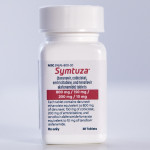Preliminary results from a major clinical trial have demonstrated that Prezista (darunavir) plus Norvir (ritonavir) is more effective than Kaletra (lopinavir/ritonavir) in treatment-experienced HIV-positive patients. The results were reviewed by Jose Valdez-Madruga, MD, of the Centro de Referência e Treinamento DST/AIDS, in São Paolo, at the fourth IAS Conference on HIV Pathogenesis, Treatment and Prevention, in Sydney, and recently published in a special HIV/AIDS edition of The Lancet.
Prezista (600 mg), taken twice daily in combination with Norvir (100 mg), was approved by the U.S. Food and Drug Administration (FDA) in June 2006, specifically for treatment-experienced HIV-positive patients, notably those with multiple-drug-resistant virus (i.e., resistance to more than one protease inhibitor). These new data suggest that Prezista/Norvir may be a better bet than Kaletra for patients with less treatment experience, including those starting a protease inhibitor (PI) for the first time.
The ongoing study, known as TITAN (TMC114/r In Treatment-Experienced Patients Naïve to lopinavir/ritonavir), has enrolled 595 treatment-experienced patients. Participants enrolled had not yet used Kaletra, had a viral load of at least 1,000 copies, and had previously failed an HIV treatment combination after at least 12 weeks (or were taking a break from treatment). Approximately 31 percent of the patients enrolled had never used a PI in the past and 82 percent had HIV susceptible to four or more PIs.
Patients were randomized to receive standard, twice-daily doses of either Prezista/Norvir or Kaletra in combination with an optimized background regimen (OBR). The OBR was individualized for each patient, based on resistance testing and prior treatment history, and included a combination of nucleoside reverse transcriptase inhibitors (NRTIs) with or without non-nucleoside reverse transcriptase inhibitors (NNRTIs).
In the analysis of 554 patients, 77 percent of those randomized to receive Prezista/Norvir had viral loads below 400 copies, compared to 68 percent of those receiving Kaletra. The 9 percent difference between the two groups was statistically significant, meaning that it wasn’t likely due to chance. Viral loads below 50 copies—“undetectable” by today’s testing standards—after 48 weeks of treatment were seen in 71 percent of the Prezista/Norvir-treated patients and 60 percent of the Kaletra-treated patients. This difference was also statistically significant.
Statistically speaking, the difference between the two groups, with respect to the percentage of patients with viral loads below 50 copies after 48 weeks, met criteria for superiority. In other words, Norvir-boosted Prezista outshined Kaletra in this population of treatment-experienced patients.
Viral load reductions were similar in both groups at week 48. The average reduction was 1.95 copies in the Prezista group, compared to a 1.72 reduction in the Kaletra group. This difference was not statistically significant.
It is also worth noting that more patients in the Kaletra group (22 percent) experienced virologic failure—defined as a viral load rebound above 400 copies—than in the Prezista/Norvir (10 percent) group. What’s more, fewer patients in the Prezista/Norvir group (21 percent), compared to those in the Kaletra group (36 percent) developed new mutations typically associated with resistance to PIs. Taken together, these data suggest that Prezista/Norvir may be associated with more durable virologic responses than Kaletra, in light of what appears to be a greater barrier against the emergence of resistant mutations.
CD4 counts increased by 88 cells in the Prezista group, compared to an 81-cell increase in the Kaletra group. No statistically significant difference was noted by Dr. Madruga.
It is not yet known how Prezista/Norvir compared to other PIs, include Kaletra, in HIV-positive patients starting antiretroviral therapy for the first time.
Approximately 7 percent of patients in both groups discontinued their assigned treatment due to side effects. In the Prezista/Norvir group, the most frequently reported moderate-to-severe side effects were diarrhea (8 percent), nausea (4 percent), and rash (3 percent). In the Kaletra group, the most frequently reported moderate-to-severe side effects were diarrhea (15 percent), nausea (4 percent) and rash (1 percent).
As for lipid levels, increases in total cholesterol were similar between the two groups after 48 weeks (32 percent in the Prezista/Norvir group and 29 percent in the Kaletra group), whereas triglyceride increases were more common among those taking Kaletra compared to those taking Prezista (25 percent vs. 19 percent).
Liver enzyme increases were documented in approximately 9 percent of all patients in both treatment groups.
Across the board, Dr. Madruga explained, the safety and tolerability of Norvir-boosted Prezista is comparable to Kaletra, with lower rates of moderate-to-severe diarrhea.






Comments
Comments